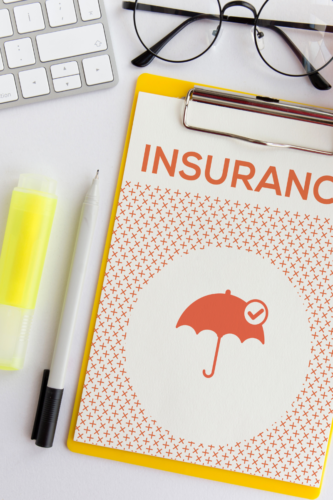Guess what? (You will not be surprised by this…)
If there’s a way for a company to make money off the probability of your misfortune, they will create insurance for that misfortune.
- Will you get sick? How sick?
- Will you die?
- Will your pet get sick or die?
- Will you break a bone?
- Will you cancel your wedding two days before it’s scheduled?
- How about getting robbed?
- Having your identity stolen?
- Will you drop your phone in the toilet?
- Will you lose at fantasy football?
- Will you say something stupid about someone else, making them mad enough to sue you for defamation?
Do you need any (or all) of these types of insurance?
The answer depends upon your particular combination of likelihood of risk and the severity of the impact of that risk should it occur.

Measuring The Severity of Financial Impact
Each of these can be measured on a spectrum–low likelihood to high likelihood and low severity to high severity.
For example, let’s take one of the silliest suggestions from the list above: losing at fantasy football. What’s the likelihood that this will happen? Pretty high, right? But what’s the severity of the impact to you, should you lose? Well, that depends on how much you bet (which you can control, by the way). But let’s hope it’s not more than ten bucks.
Would that be worth buying insurance for? (Hint: how about you don’t play fantasy football and you stick that $10 in your high-yield savings account? Just a thought.)
Here’s another example that’s more realistic: Let’s say you drive a 25-year-old car that has a Kelley Blue Book value of $2000. Liability insurance (the coverage required by law, plus a little extra) costs $346 every 6 months or $692 per year if the policy is paid in full at every renewal. Adding collision insurance would cost $125 every 6 months (or $250 per year), and adding comprehensive insurance (protection for fire, theft, vandalism, glass breakage and flying objects) costs just $36 per policy period (or $72 per year). Cheap, right? Note: these numbers are based on a middle-aged female driver, who is, statistically, just about the safest driver on the road in Washington State in 2023. As the saying goes, your mileage will vary.
But remember that the vehicle is valued at only $2000, and that would be the cap on the benefit payout should something happen to the vehicle. So you could pay up to $322 a year to protect against possible damages of $2000.
Worth it? Or not?
This depends a lot on how valuable the vehicle is to you in terms of use rate, seating capacity, commuting to your job, etc. So there are many factors other than the direct cost of the insurance and the direct cost of replacing the vehicle. It could very well be that replacing the vehicle to your standard of need would cost a lot more than $2000. But your insurance coverage is tied to that Kelley Blue Book (or equivalent) number.
Here is an excellent resource for determining what car insurance, and how much you need.

Emergency Fund
This is where the magic concept called an emergency fund comes into play.
Emergency funds are basically a form of self-insurance against whatever life might throw at you (which will certainly have a price tag attached).
It’s always a good idea to review your insurance coverage with your emergency fund in mind. If you’ve chosen low-premium/high-deductible coverages, then a great goal would be to build your emergency fund to the level where it covers all your possible deductibles for the year, plus a month or two of rent/mortgage payments. That way, if you get in a car wreck that puts you (and your vehicle) out of commission for a while, you have the money saved to pay your car insurance deductible, your health insurance deductible, and you have enough money to continue paying for the safe place you’re living while you recuperate.
The higher your deductible choices, the more you should have in your emergency fund. And if you’re choosing to self-insure, let’s say with the old vehicle example above, then your emergency fund should also have enough in it to purchase a replacement vehicle or cover some pretty expensive repairs.
Wow. It’s true that very few people have this kind of safety net built in terms of a sufficient emergency fund.
But it’s an awesome goal! And will give you some solid numbers to work toward.

Life Insurance
What if the severity of the possible impact would be beyond what you could reasonably cover with your emergency fund? That’s the time when insurance coverage is most vital.
A great example of this type of coverage is life insurance…
If you have kids at home, and you (or your partner) die, the loss of income will hit your family hard. Families are at their most vulnerable when the likelihood is low (dying in your 30s or 40s) but the severity of the risk is high (loss of the primary income, or loss of the secondary income and child care for young kids). This is when a monthly payment for life insurance makes the most sense.
There’s really no upper limit to how much life insurance can cost…but you can keep the cost lower by buying a term policy that covers just when you have kids at home and by keeping the benefit amount at a reasonable level. You can decide if you want the policy benefit to pay off the house, provide X number of years of replacement income, pay for the kids’ college, or any combination thereof. What you’re really buying is time. Time for the surviving spouse to grieve and then get back on their feet financially.
Here is a great resource for knowing more about the different types of term life insurance and their rankings.
In Conclusion
So, to wrap up, think of all the bad things that could happen to you and yours. (Fun, right?) Then plot those things on your severity vs likelihood matrix. Any bad things that are high severity are worthy candidates for considering buying insurance coverage. Focus on the highly likely and highly severe bad things first, but don’t neglect the less likely but possibly even more severe possibilities, either.
You’ll feel better afterward, I promise. I’m firmly convinced that ambiguity exacerbates stress. Assigning number/dollar values to your worst fears actually shows you the possibilities available to help mitigate some of that risk.
And then you’ll be able to take action toward your plan, which is the best feeling of all.

Tina Birch
Tina is one of Birch’s Financial Literacy Counselors who meet with our participants regularly to discuss how to meet their financial goals. She is also an avid reader and writer so we are excited to have her share her knowledge about financial literacy with us here on The Birch Blog.
